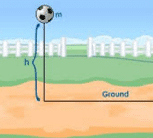gravitational potential energy : Definition,formula and examples
Gravitational potential energy is defined as the “energy of an object due to Earth’s gravity”.OR it is the product of the object’s weight and height. It is the most common example of P.E. Its formula is:
W = mgh
It means the higher an object the higher will be its Gravitational P.E.
Examples of gravitational potential energy in everyday life
In many situations, it seems through energy has been stored in a system, to be recovered later. For example, you must do work to lift a heavy stone over your head. It seems reasonable that in hosting the stone into kinetic energy when you let the stone fall.
This example points to the idea of energy associated with the position bodies in a system. This kind of energy is a measure of the potential or possibility for work to be done; when a stone is raised into the air, there is a potential for work to be done on it by the gravitational force, but only if the stone is allowed to fall to the ground.
For this reason, the energy associated with the position is called potential energy. Our discussion suggests that there is potential energy associated with a body’s weight and its height above the ground. We call this gravitational potential energy.
We now have two ways to describe what happens when a body falls without air resistance. One way is to say that GPE decreases and the falling body’s kinetic energy increases.
The other way, which we learned, is that a falling body’s kinetic energy increases because the force of the earth’s gravity (the body’s weight) does work on the body. Later in the section, we’ll use the work-energy theorem to show that these two descriptions are equivalent.
Let’s see the video to see more examples about gravitational P.E.
Derivation of gravitational potential energy
Let a body of mass m as shown in the figure is raised up through height h from the ground. The body will acquire potential energy equal to the work done is lifting it to height h.
So potential energy P.E = (F)(h)
P.E=(W)(h) …….(1)
Where the weight of the body is W= mg
By putting the value of W in equation (1) we have:
P.E =mgh
Related topics in our site:

For latest news you have to ggo to seee world-wide-web and on the web I found this web page
as a best site for mosst up-to-date updates.